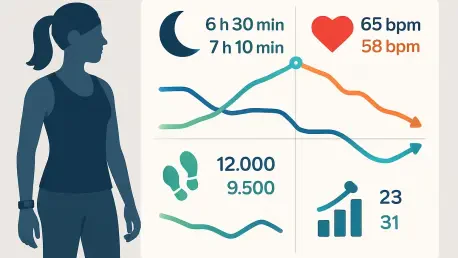In an era where wearable technology is becoming an indispensable part of daily health management, a new development from Fitbit has captured attention with its potential to transform how individuals monitor their well-being. Imagine a device on your wrist that not only tracks your steps and sleep but also quietly observes subtle shifts in your body’s vital signs, alerting you to possible concerns before they become apparent. Fitbit has introduced an innovative experimental tool within its Fitbit Labs platform, designed to detect unusual trends in physiological data. This feature aims to empower users by providing early insights into their health, focusing on metrics like heart rate variability and respiration rate during sleep. While still in a research phase, this initiative signals a significant step toward proactive health monitoring, sparking curiosity about how such technology might evolve to support personal wellness in the years ahead.
Exploring the Mechanics of the New Feature
How Unusual Trend Detection Works
At the core of Fitbit’s latest experimental offering is a system that meticulously analyzes a user’s personal health data to identify deviations from their established baselines. This tool tracks critical metrics such as sleeping heart rate during non-REM phases, respiration rate while asleep, and heart rate variability, compiling a detailed picture of an individual’s physiological patterns. When a significant shift is detected, the Fitbit app sends a notification to the user, encouraging them to log any related feelings or potential triggers for the change, such as stress or illness. Once the metrics stabilize and return to normal, a follow-up alert is issued, accompanied by general recovery tips. It’s important to note that this system is not intended as a medical diagnostic tool but rather as a research initiative to explore early detection possibilities. This focus on user engagement through notifications and logging ensures that participants remain active contributors to the data collection process, helping to refine the feature’s capabilities over time.
Data Points and User Interaction
Beyond the primary metrics, the scope of data collection for this experimental feature extends to additional indicators like SpO2 levels, skin temperature, and detailed sleep patterns, providing a comprehensive dataset for analysis. Survey responses from users, along with potential activity and stress scores, further enrich the information pool, offering context to the detected trends. Fitbit has designed the interaction process to be user-friendly, particularly for the select group in the United States who meet the eligibility criteria, which include being over 22 years old, using the app in English on an Android device, and signing in with a Google Account. Participants access the feature via the “You” tab in the app, where they must accept a research consent form to join the study. Weekly check-in messages are sent to ensure no changes go unnoticed, even if no unusual trends are flagged. This consistent communication underscores the dual purpose of supporting users while gathering valuable feedback to enhance the underlying algorithm.
Broader Implications and Future Prospects
Industry Trends and Competitive Landscape
The introduction of Unusual Trend Detection by Fitbit aligns with a growing movement in the wearable tech industry toward proactive health monitoring, a trend seen in offerings from various competitors who also integrate similar functionalities into their devices. While other brands have developed tools to alert users to potential health anomalies, Fitbit’s approach stands out due to its experimental nature and emphasis on user feedback as a cornerstone of development. This research-focused strategy allows the company to test real-world applications while refining the technology, setting it apart in a crowded market. The broader industry consensus points to the value of early detection in empowering users to address health concerns before they escalate, even as these tools remain outside the realm of medical validation. Fitbit’s commitment to evolving its system through participant input highlights a forward-thinking approach, potentially influencing how other manufacturers prioritize user-driven innovation in their own health monitoring solutions.
Privacy Measures and Long-Term Vision
A critical aspect of this experimental feature lies in Fitbit’s handling of user privacy, a concern paramount in an age of extensive data collection. To safeguard personal information, the company ensures that identifiable data is stripped before storage or analysis, assigning each participant a unique ID and restricting backend access to authorized personnel only. This robust privacy framework aims to build trust among users who contribute to the research by sharing sensitive health metrics. Looking ahead, the long-term potential for integrating such a feature into Fitbit’s core offerings remains uncertain, yet its presence in Fitbit Labs suggests it forms part of a strategic vision for future health innovations. The active solicitation of feedback indicates an intent to refine the tool, possibly expanding its accessibility and precision. As the wearable tech landscape continues to evolve, initiatives like this one have laid the groundwork for empowering users with actionable health insights, balancing technological advancement with ethical data practices in a way that could shape industry standards moving forward.









